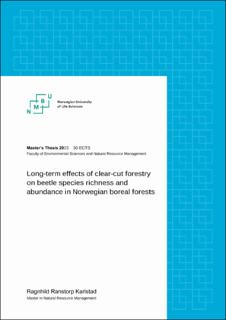| dc.description.abstract | For the last approximately 70 years, clear-cutting has been the common method in Scandinavian forestry. Since more than half of the Scandinavian species live in the forest, this intensive forestry method has caused concern about its effects on biodiversity. Since the early clear-cut forests now have reached the later logging class, it is possible to investigate how this forestry method impacts the ecological environment on a long-term basis. A large portion of the beetle (Coleoptera) species are saproxylic and thus dependent on deadwood, which is one of the ecological factors that have been altered by forestry. This study aims to investigate whether beetle biodiversity differs between older clear-cut forests and old near-natural forests.
A total of 17 970 individuals of beetles, represented by 445 species, were collected using window traps in ten site pairs of clear-cut forests and near-natural forests in Southeastern Norway. The volume and diameter of lying deadwood in each study plot were measured. From this, the variation in the number of beetle species and individuals between the two forest types was compared to see if logging history affects the beetle biodiversity. Correspondingly, the patterns of saproxylic species, different feeding guilds and red-listed species were analyzed as well. Beetle biodiversity was also examined in relation to the volumes of deadwood available.
The near-natural and clear-cut forests differed in relation to deadwood as near-natural plots always had higher volumes, even though there was a large variation between sites. In addition, there were clearly more large diameter logs of deadwood in near-natural forests. Surprisingly, forest type did not affect overall species richness or abundance to a large extent, but more saproxylic individuals were caught in near-natural plots. Deadwood, on the other hand, had more of an effect on beetle biodiversity, as higher deadwood volumes led to a higher total species richness, and large diameter deadwood was of special importance for saproxylic beetles. Detritivores also increased in both species richness and abundance with higher deadwood volumes. Even though the type of forest did not show many significant differences besides deadwood volumes, this study shows that ecological factors available in the forest stands are of importance for beetle diversity, and thus that availability of deadwood resources needs to be assessed in forest management. | |
